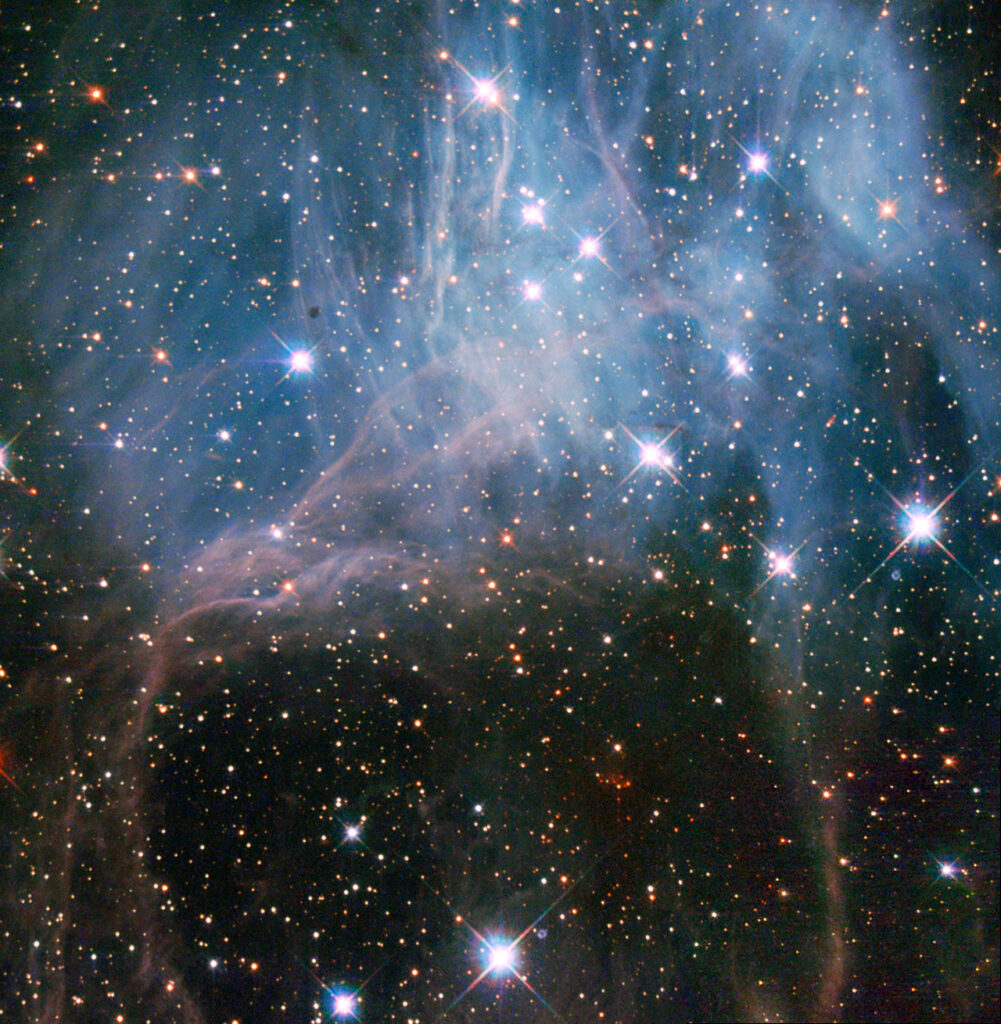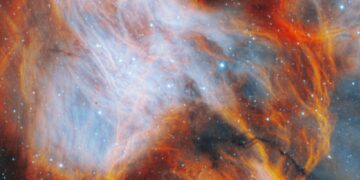Recently, the Gemini South telescope, part of the International Gemini Observatory, unveiled a breathtaking image of this cluster, revealing a scene reminiscent of a “flaming flower.” This vivid portrayal not only enchants the eye but also offers profound insights into the life cycles of stars and the dynamic processes shaping our universe.
A Celestial Bloom: The Visual Splendor of NGC 2040
The newly released image of NGC 2040 showcases wispy layers of red, orange, and yellow hues, painting a picture that resembles a vibrant cosmic rose. This striking visual is not merely a feast for the eyes but a testament to the energetic processes occurring within the cluster.
The colors emanate from hydrogen and oxygen atoms excited by ultraviolet radiation from nearby massive stars, emitting light across a spectrum from ultraviolet to infrared wavelengths.
Specialized filters on the Gemini South telescope isolate specific wavelengths, allowing us to witness the deep reds and oranges of glowing hydrogen and the light blues of oxygen. The bright white regions indicate areas rich in both elements, highlighting zones of intense stellar activity.
The Anatomy of NGC 2040: A Stellar Nursery
Located approximately 160,000 light-years from Earth in the constellation Dorado, NGC 2040 is a young open cluster classified as an OB association due to its abundance of O-type and B-type stars.
These massive stars, more than a dozen within the cluster, are characterized by their high temperatures and luminosities. However, their brilliance comes at a cost; they lead short lives, burning intensely for only a few million years before meeting their demise in cataclysmic supernova explosions.

These explosive events play a crucial role in sculpting the surrounding nebula, as the energy released drives shockwaves that compress nearby gas and dust, triggering the formation of new stars. Thus, NGC 2040 serves as a vivid illustration of the cyclical nature of stellar evolution, where the death of one generation seeds the birth of the next.
The Role of Gemini South: Peering into the Heart of the Cluster
Capturing the intricate details of NGC 2040 requires advanced observational capabilities, and the Gemini South telescope rises to the occasion. As one half of the International Gemini Observatory, supported by the U.S.
National Science Foundation and operated by NSF’s NOIRLab, Gemini South is equipped with an 8-meter optical/infrared telescope. This instrumentation is adept at penetrating the veils of interstellar dust, allowing astronomers to observe both the brilliant stars and the diffuse glow of the encompassing nebula.
By employing filters that select specific wavelengths of emitted light, the telescope reveals the complex interplay of elements within the cluster, providing a window into the processes of stellar birth and death.
The Larger Context: NGC 2040 within LH 88
NGC 2040 is part of a more extensive structure known as LH 88, one of the largest active star-forming regions in the LMC. This massive complex of interstellar gas and young stars exemplifies the robust star-forming activity characteristic of the LMC.
The interactions within LH 88, driven by stellar winds and supernova-induced shockwaves, lead to the continuous recycling of material, fostering the emergence of new stellar generations. Studying such regions enhances our comprehension of the mechanisms governing star formation and the evolution of galaxies.
Implications for Our Cosmic Origins
The processes observed in NGC 2040 offer a glimpse into the history of our own solar system. It’s widely believed that the Sun formed within a similar open cluster approximately five billion years ago.
Over time, the stars within such clusters disperse, and the residual gas and dust either coalesce into new stars and planetary systems or are expelled into interstellar space.
By examining clusters like NGC 2040, scientists gain valuable insights into the conditions that prevailed during the early stages of our solar system’s formation, shedding light on the origins of planets and, potentially, life itself.
The Ephemeral Beauty of Cosmic Structures
While the image of NGC 2040 captivates with its beauty, it’s essential to recognize the transient nature of such structures. In cosmic terms, the nebula’s current appearance is fleeting.
Within a few million years—a mere blink in the universe’s timeline—the gas and dust will either collapse to form new stars and planetary systems or dissipate into the surrounding space.
This impermanence underscores the dynamic and ever-evolving character of the cosmos, where creation and destruction are in perpetual balance.
Conclusion: Embracing the Cosmic Dance
The Gemini South telescope’s portrayal of NGC 2040 as a “flaming flower” offers more than aesthetic pleasure; it serves as a powerful reminder of the universe’s continuous cycle of life, death, and rebirth.



















